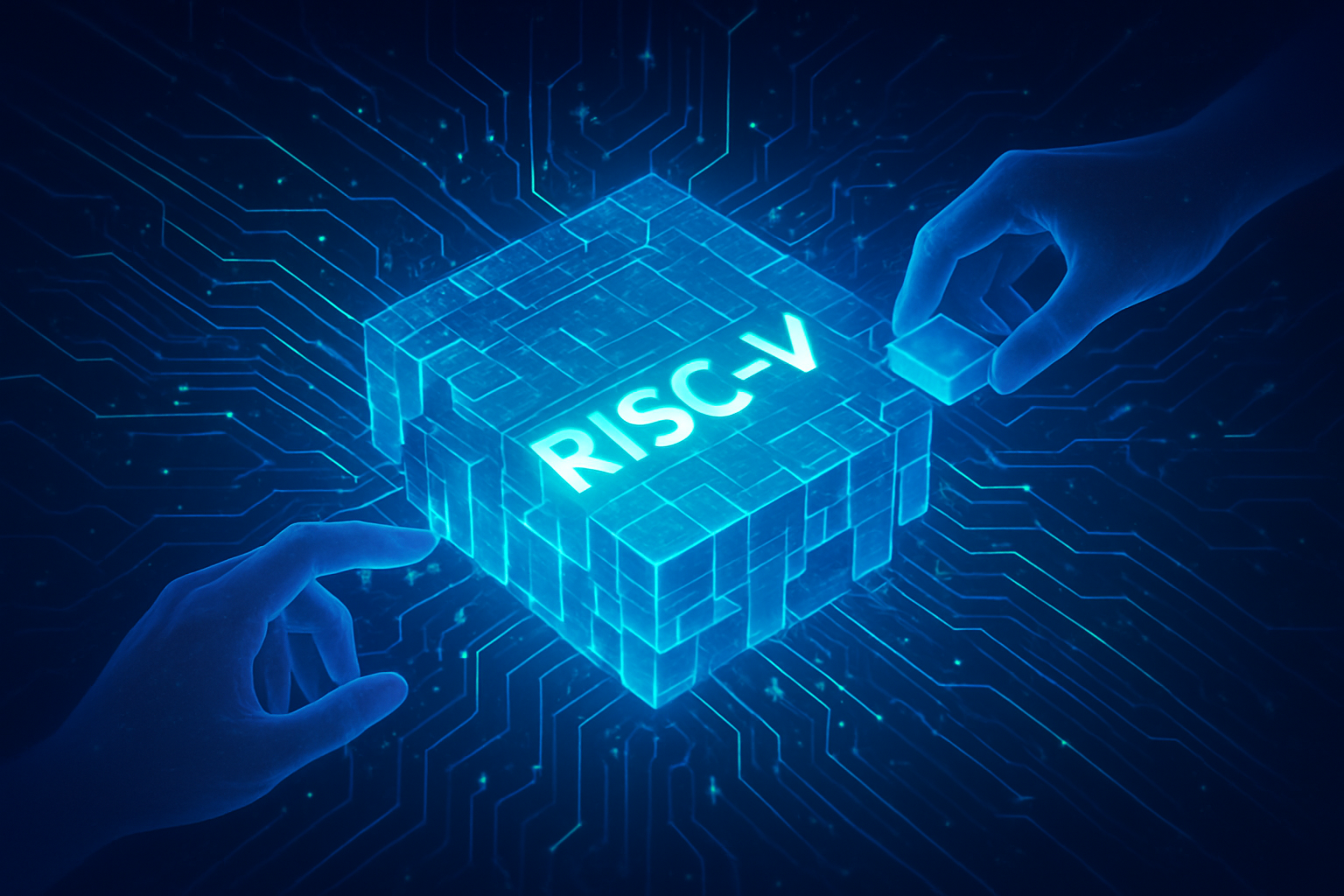The artificial intelligence landscape is witnessing a profound shift, driven not only by advancements in algorithms but also by a quiet revolution in hardware. At its heart is the RISC-V (Reduced Instruction Set Computer – Five) architecture, an open-standard Instruction Set Architecture (ISA) that is rapidly emerging as a transformative alternative for AI hardware innovation. As of November 2025, RISC-V is no longer a nascent concept but a formidable force, democratizing chip design, fostering unprecedented customization, and driving cost efficiencies in the burgeoning AI domain. Its immediate significance lies in its ability to challenge the long-standing dominance of proprietary architectures like Arm and x86, thereby unlocking new avenues for innovation and accelerating the pace of AI development across the globe.
This open-source paradigm is significantly lowering the barrier to entry for AI chip development, enabling a diverse ecosystem of startups, research institutions, and established tech giants to design highly specialized and efficient AI accelerators. By eliminating the expensive licensing fees associated with proprietary ISAs, RISC-V empowers a broader array of players to contribute to the rapidly evolving field of AI, fostering a more inclusive and competitive environment. The ability to tailor and extend the instruction set to specific AI applications is proving critical for optimizing performance, power, and area (PPA) across a spectrum of AI workloads, from energy-efficient edge computing to high-performance data centers.
Technical Prowess: RISC-V's Edge in AI Hardware
RISC-V's fundamental design philosophy, emphasizing simplicity, modularity, and extensibility, makes it exceptionally well-suited for the dynamic demands of AI hardware.
A cornerstone of RISC-V's appeal for AI is its customizability and extensibility. Unlike rigid proprietary ISAs, RISC-V allows developers to create custom instructions that precisely accelerate domain-specific AI workloads, such as fused multiply-add (FMA) operations, custom tensor cores for sparse models, quantization, or tensor fusion. This flexibility facilitates the tight integration of specialized hardware accelerators, including Neural Processing Units (NPUs) and General Matrix Multiply (GEMM) accelerators, directly with the RISC-V core. This hardware-software co-optimization is crucial for enhancing efficiency in tasks like image signal processing and neural network inference, leading to highly specialized and efficient AI accelerators.
The RISC-V Vector Extension (RVV) is another critical component for AI acceleration, offering Single Instruction, Multiple Data (SIMD)-style parallelism with superior flexibility. Its vector-length agnostic (VLA) model allows the same program to run efficiently on hardware with varying vector register lengths (e.g., 128-bit to 16 kilobits) without recompilation, ensuring scalability from low-power embedded systems to high-performance computing (HPC) environments. RVV natively supports various data types essential for AI, including 8-bit, 16-bit, 32-bit, and 64-bit integers, as well as single and double-precision floating points. Efforts are also underway to fast-track support for bfloat16 (BF16) and 8-bit floating-point (FP8) data types, which are vital for enhancing the efficiency of AI training and inference. Benchmarking suggests that RVV can achieve 20-30% better utilization in certain convolutional operations compared to ARM's Scalable Vector Extension (SVE), attributed to its flexible vector grouping and length-agnostic programming.
Modularity is intrinsic to RISC-V, starting with a fundamental base ISA (RV32I or RV64I) that can be selectively expanded with optional standard extensions (e.g., M for integer multiply/divide, V for vector processing). This "lego-brick" approach enables chip designers to include only the necessary features, reducing complexity, silicon area, and power consumption, making it ideal for heterogeneous System-on-Chip (SoC) designs. Furthermore, RISC-V AI accelerators are engineered for power efficiency, making them particularly well-suited for energy-constrained environments like edge computing and IoT devices. Some analyses indicate RISC-V can offer approximately a 3x advantage in computational performance per watt compared to ARM and x86 architectures in specific AI contexts due to its streamlined instruction set and customizable nature. While high-end RISC-V designs are still catching up to the best ARM offers, the performance gap is narrowing, with near parity projected by the end of 2026.
Initial reactions from the AI research community and industry experts as of November 2025 are largely optimistic. Industry reports project substantial growth for RISC-V, with Semico Research forecasting a staggering 73.6% annual growth in chips incorporating RISC-V technology, anticipating 25 billion AI chips by 2027 and generating $291 billion in revenue. Major players like Google (NASDAQ: GOOGL), NVIDIA (NASDAQ: NVDA), and Samsung (KRX: 005930) are actively embracing RISC-V for various applications, from controlling GPUs to developing next-generation AI chips. The maturation of the RISC-V ecosystem, bolstered by initiatives like the RVA23 application profile and the RISC-V Software Ecosystem (RISE), is also instilling confidence.
Reshaping the AI Industry: Impact on Companies and Competitive Dynamics
The emergence of RISC-V is fundamentally altering the competitive landscape for AI companies, tech giants, and startups, creating new opportunities and strategic advantages.
AI startups and smaller players are among the biggest beneficiaries. The royalty-free nature of RISC-V significantly lowers the barrier to entry for chip design, enabling agile startups to rapidly innovate and develop highly specialized AI solutions without the burden of expensive licensing fees. This fosters greater control over intellectual property and allows for bespoke implementations tailored to unique AI workloads. Companies like ChipAgents, an AI startup focused on semiconductor design and verification, recently secured a $21 million Series A round, highlighting investor confidence in this new paradigm.
Tech giants are also strategically embracing RISC-V to gain greater control over their hardware infrastructure, reduce reliance on third-party licenses, and optimize chips for specific AI workloads. Google (NASDAQ: GOOGL) has integrated RISC-V into its Coral NPU for edge AI, while NVIDIA (NASDAQ: NVDA) utilizes RISC-V cores extensively within its GPUs for control tasks and has announced CUDA support for RISC-V, enabling it as a main processor in AI systems. Samsung (KRX: 005930) is developing next-generation AI chips based on RISC-V, including the Mach 1 AI inference chip, to achieve greater technological independence. Other major players like Broadcom (NASDAQ: AVGO), Meta (NASDAQ: META), MediaTek (TPE: 2454), Qualcomm (NASDAQ: QCOM), and Renesas (TYO: 6723) are actively validating RISC-V's utility across various semiconductor applications. Qualcomm, a leader in mobile, IoT, and automotive, is particularly well-positioned in the Edge AI semiconductor market, leveraging RISC-V for power-efficient, cost-effective inference at scale.
The competitive implications for established players like Arm (NASDAQ: ARM) and Intel (NASDAQ: INTC) are substantial. RISC-V's open and customizable nature directly challenges the proprietary models that have long dominated the market. This competition is forcing incumbents to innovate faster and could disrupt existing product roadmaps. The ability for companies to "own the design" with RISC-V is a key advantage, particularly in industries like automotive where control over the entire stack is highly valued. The growing maturity of the RISC-V ecosystem, coupled with increased availability of development tools and strong community support, is attracting significant investment, further intensifying this competitive pressure.
RISC-V is poised to disrupt existing products and services across several domains. In Edge AI devices, its low-power and extensible nature is crucial for enabling ultra-low-power, always-on AI in smartphones, IoT devices, and wearables, potentially making older, less efficient hardware obsolete faster. For data centers and cloud AI, RISC-V is increasingly adopted for higher-end applications, with the RVA23 profile ensuring software portability for high-performance application processors, leading to more energy-efficient and scalable cloud computing solutions. The automotive industry is experiencing explosive growth with RISC-V, driven by the demand for low-cost, highly reliable, and customizable solutions for autonomous driving, ADAS, and in-vehicle infotainment.
Strategically, RISC-V's market positioning is strengthening due to its global standardization, exemplified by RISC-V International's approval as an ISO/IEC JTC1 PAS Submitter in November 2025. This move towards global standardization, coupled with an increasingly mature ecosystem, solidifies its trajectory from an academic curiosity to an industrial powerhouse. The cost-effectiveness and reduced vendor lock-in provide strategic independence, a crucial advantage amidst geopolitical shifts and export restrictions. Industry analysts project the global RISC-V CPU IP market to reach approximately $2.8 billion by 2025, with chip shipments increasing by 50% annually between 2024 and 2030, reaching over 21 billion chips by 2031, largely credited to its increasing use in Edge AI deployments.
Wider Significance: A New Era for AI Hardware
RISC-V's rise signifies more than just a new chip architecture; it represents a fundamental shift in how AI hardware is designed, developed, and deployed, resonating with broader trends in the AI landscape.
Its open and modular nature aligns perfectly with the democratization of AI. By removing the financial and technical barriers of proprietary ISAs, RISC-V empowers a wider array of organizations, from academic researchers to startups, to access and innovate at the hardware level. This fosters a more inclusive and diverse environment for AI development, moving away from a few dominant players. This also supports the drive for specialized and custom hardware, a critical need in the current AI era where general-purpose architectures often fall short. RISC-V's customizability allows for domain-specific accelerators and tailored instruction sets, crucial for optimizing the diverse and rapidly evolving workloads of AI.
The focus on energy efficiency for AI is another area where RISC-V shines. As AI demands ever-increasing computational power, the need for energy-efficient solutions becomes paramount. RISC-V AI accelerators are designed for minimal power consumption, making them ideal for the burgeoning edge AI market, including IoT devices, autonomous vehicles, and wearables. Furthermore, in an increasingly complex geopolitical landscape, RISC-V offers strategic independence for nations and companies seeking to reduce reliance on foreign chip design architectures and maintain sovereign control over critical AI infrastructure.
RISC-V's impact on innovation and accessibility is profound. It lowers barriers to entry and enhances cost efficiency, making advanced AI development accessible to a wider array of organizations. It also reduces vendor lock-in and enhances flexibility, allowing companies to define their compute roadmap and innovate without permission, leading to faster and more adaptable development cycles. The architecture's modularity and extensibility accelerate development and customization, enabling rapid iteration and optimization for new AI algorithms and models. This fosters a collaborative ecosystem, uniting global experts to define future AI solutions and advance an interoperable global standard.
Despite its advantages, RISC-V faces challenges. The software ecosystem maturity is still catching up to proprietary alternatives, with a need for more optimized compilers, development tools, and widespread application support. Projects like the RISC-V Software Ecosystem (RISE) are actively working to address this. The potential for fragmentation due to excessive non-standard extensions is a concern, though standardization efforts like the RVA23 profile are crucial for mitigation. Robust verification and validation processes are also critical to ensure reliability and security, especially as RISC-V moves into high-stakes applications.
The trajectory of RISC-V in AI draws parallels to significant past architectural shifts. It echoes ARM challenging x86's dominance in mobile computing, providing a more power-efficient alternative that disrupted an established market. Similarly, RISC-V is poised to do the same for low-power, edge computing, and increasingly for high-performance AI. Its role in enabling specialized AI accelerators also mirrors the pivotal role GPUs played in accelerating AI/ML tasks, moving beyond general-purpose CPUs to hardware optimized for parallelizable computations. This shift reflects a broader trend where future AI breakthroughs will be significantly driven by specialized hardware innovation, not just software. Finally, RISC-V represents a strategic shift towards open standards in hardware, mirroring the impact of open-source software and fundamentally reshaping the landscape of AI development.
The Road Ahead: Future Developments and Expert Predictions
The future for RISC-V in AI hardware is dynamic and promising, marked by rapid advancements and growing expert confidence.
In the near-term (2025-2026), we can expect continued development of specialized Edge AI chips, with companies actively releasing and enhancing open-source hardware platforms designed for efficient, low-power AI at the edge, integrating AI accelerators natively. The RISC-V Vector Extension (RVV) will see further enhancements, providing flexible SIMD-style parallelism crucial for matrix multiplication, convolutions, and attention kernels in neural networks. High-performance cores like Andes Technology's AX66 and Cuzco processors are pushing RISC-V into higher-end AI applications, with Cuzco expected to be available to customers by Q4 2025. The focus on hardware-software co-design will intensify, ensuring AI-focused extensions reflect real workload needs and deliver end-to-end optimization.
Long-term (beyond 2026), RISC-V is poised to become a foundational technology for future AI systems, supporting next-generation AI systems with scalability for both performance and power-efficiency. Platforms are being designed with enhanced memory bandwidth, vector processing, and compute capabilities to enable the efficient execution of large AI models, including Transformers and Large Language Models (LLMs). There will likely be deeper integration with neuromorphic hardware, enabling seamless execution of event-driven neural computations. Experts predict RISC-V will emerge as a top Instruction Set Architecture (ISA), particularly in AI and embedded market segments, due to its power efficiency, scalability, and customizability. Omdia projects RISC-V-based chip shipments to increase by 50% annually between 2024 and 2030, reaching 17 billion chips shipped in 2030, with a market share of almost 25%.
Potential applications and use cases on the horizon are vast, spanning Edge AI (autonomous robotics, smart sensors, wearables), Data Centers (high-performance AI accelerators, LLM inference, cloud-based AI-as-a-Service), Automotive (ADAS, computer vision), Computational Neuroscience, Cryptography and Codecs, and even Personal/Work Devices like PCs, laptops, and smartphones.
However, challenges remain. The software ecosystem maturity requires continuous effort to develop consistent standards, comprehensive debugging tools, and a wider range of optimized software support. While IP availability is growing, there's a need for a broader range of readily available, optimized Intellectual Property (IP) blocks specifically for AI tasks. Significant investment is still required for the continuous development of both hardware and a robust software ecosystem. Addressing security concerns related to its open standard nature and potential geopolitical implications will also be crucial.
Expert predictions as of November 2025 are overwhelmingly positive. RISC-V is seen as a "democratizing force" in AI hardware, fostering experimentation and cost-effective deployment. Analysts like Richard Wawrzyniak of SHD Group emphasize that AI applications are a significant "tailwind" driving RISC-V adoption. NVIDIA's endorsement and commitment to porting its CUDA AI acceleration stack to the RVA23 profile validate RISC-V's importance for mainstream AI applications. Experts project performance parity between high-end Arm and RISC-V CPU cores by the end of 2026, signaling a shift towards accelerated AI compute solutions driven by customization and extensibility.
Comprehensive Wrap-up: A New Dawn for AI Hardware
The RISC-V architecture is undeniably a pivotal force in the evolution of AI hardware, offering an open-source alternative that is democratizing design, accelerating innovation, and profoundly reshaping the competitive landscape. Its open, royalty-free nature, coupled with unparalleled customizability and a growing ecosystem, positions it as a critical enabler for the next generation of AI systems.
The key takeaways underscore RISC-V's transformative potential: its modular design enables precise tailoring for AI workloads, driving cost-effectiveness and reducing vendor lock-in; advancements in vector extensions and high-performance cores are rapidly achieving parity with proprietary architectures; and a maturing software ecosystem, bolstered by industry-wide collaboration and initiatives like RISE and RVA23, is cementing its viability.
This development marks a significant moment in AI history, akin to the open-source software movement's impact on software development. It challenges the long-standing dominance of proprietary chip architectures, fostering a more inclusive and competitive environment where innovation can flourish from a diverse set of players. By enabling heterogeneous and domain-specific architectures, RISC-V ensures that hardware can evolve in lockstep with the rapidly changing demands of AI algorithms, from edge devices to advanced LLMs.
The long-term impact of RISC-V is poised to be profound, creating a more diverse and resilient semiconductor landscape, driving future AI paradigms through its extensibility, and reinforcing the broader open hardware movement. It promises a future of unprecedented innovation and broader access to advanced computing capabilities, fostering digital sovereignty and reducing geopolitical risks.
In the coming weeks and months, several key developments bear watching. Anticipate further product launches and benchmarks from new RISC-V processors, particularly in high-performance computing and data center applications, following events like the RISC-V Summit North America. The continued maturation of the software ecosystem, especially the integration of CUDA for RISC-V, will be crucial for enhancing software compatibility and developer experience. Keep an eye on specific AI hardware releases, such as DeepComputing's upcoming 50 TOPS RISC-V AI PC, which will demonstrate real-world capabilities for local LLM execution. Finally, monitor the impact of RISC-V International's global standardization efforts as an ISO/IEC JTC1 PAS Submitter, which will further accelerate its global deployment and foster international collaboration in projects like Europe's DARE initiative. In essence, RISC-V is no longer a niche player; it is a full-fledged competitor in the semiconductor landscape, particularly within AI, promising a future of unprecedented innovation and broader access to advanced computing capabilities.
This content is intended for informational purposes only and represents analysis of current AI developments.
TokenRing AI delivers enterprise-grade solutions for multi-agent AI workflow orchestration, AI-powered development tools, and seamless remote collaboration platforms.
For more information, visit https://www.tokenring.ai/.









